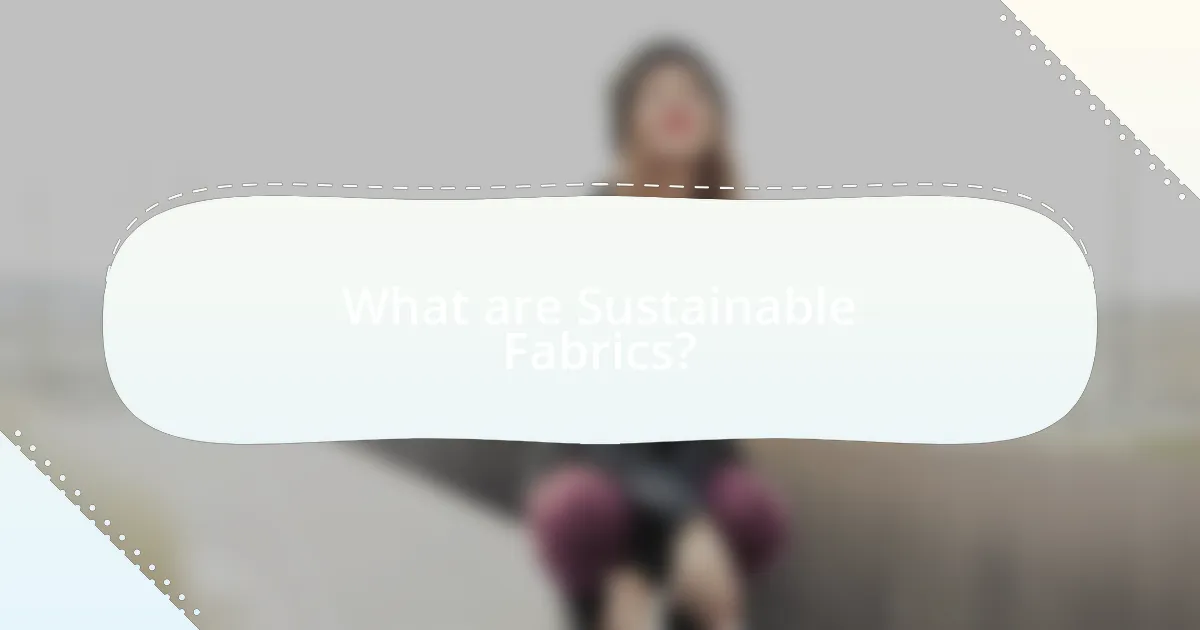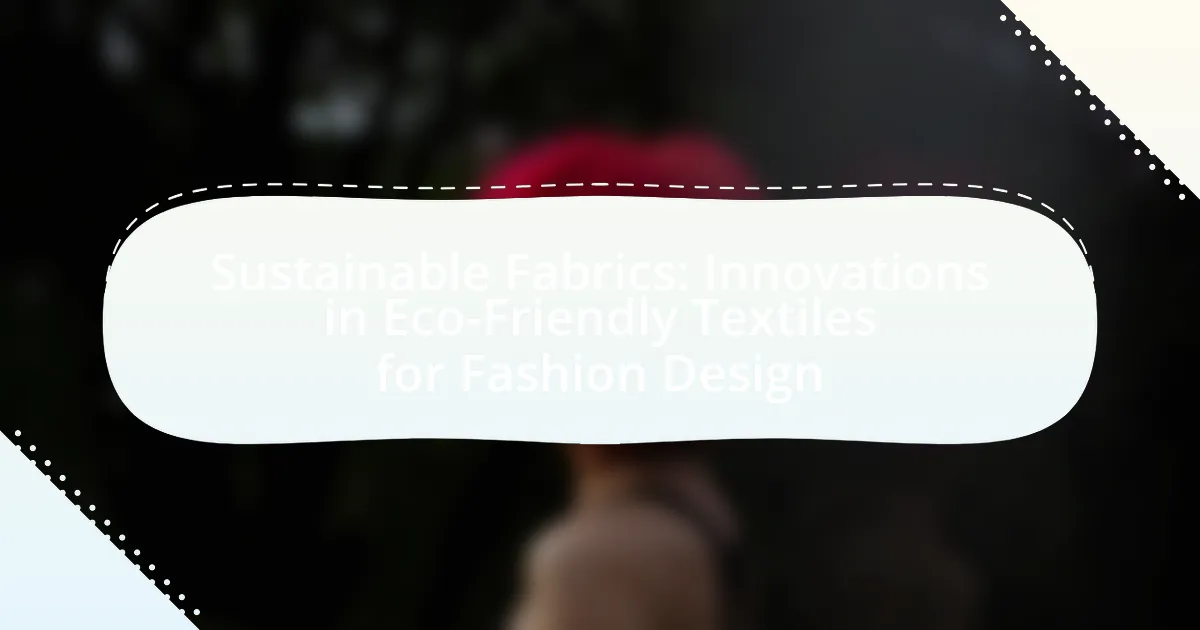Sustainable fabrics are textiles produced with minimal environmental impact, utilizing eco-friendly materials such as organic cotton, hemp, Tencel, and recycled polyester. This article explores the differences between sustainable and traditional textiles, the importance of material sourcing, and the environmental benefits of using sustainable fabrics, including reduced carbon footprints and waste. It also highlights innovations driving the development of eco-friendly textiles, the role of technology in production, and the challenges designers face when incorporating sustainable materials into fashion design. Additionally, the article discusses future trends, consumer demand, and best practices for promoting sustainable fabrics in the industry.

What are Sustainable Fabrics?
Sustainable fabrics are textiles produced with minimal environmental impact, utilizing eco-friendly materials and processes. These fabrics often include organic cotton, hemp, Tencel, and recycled polyester, which reduce resource consumption and pollution during production. For instance, organic cotton is grown without synthetic pesticides, significantly lowering chemical runoff into ecosystems. Additionally, Tencel, made from sustainably sourced wood pulp, uses a closed-loop process that recycles water and solvents, minimizing waste. The adoption of sustainable fabrics is crucial in the fashion industry, as it addresses the urgent need for environmentally responsible practices amid growing concerns over textile waste and resource depletion.
How do Sustainable Fabrics differ from traditional textiles?
Sustainable fabrics differ from traditional textiles primarily in their environmental impact and production processes. Sustainable fabrics are made from renewable resources, such as organic cotton or recycled materials, which reduce reliance on fossil fuels and minimize waste. In contrast, traditional textiles often utilize non-renewable resources and chemical-intensive processes that contribute to pollution and resource depletion. For example, the production of conventional cotton requires significant water and pesticide use, while sustainable cotton farming practices aim to conserve water and eliminate harmful chemicals. This distinction highlights the commitment of sustainable fabrics to eco-friendly practices and reduced ecological footprints.
What materials are considered sustainable in fabric production?
Sustainable materials in fabric production include organic cotton, hemp, Tencel (lyocell), and recycled polyester. Organic cotton is grown without synthetic pesticides or fertilizers, reducing environmental impact. Hemp requires minimal water and no pesticides, making it a highly sustainable crop. Tencel is produced from sustainably sourced wood pulp and uses a closed-loop process that recycles water and solvents. Recycled polyester is made from post-consumer plastic bottles, diverting waste from landfills and reducing the need for virgin materials. These materials contribute to eco-friendly textile production by minimizing resource consumption and environmental harm.
Why is the sourcing of materials important for sustainability?
The sourcing of materials is crucial for sustainability because it directly impacts environmental health, resource conservation, and social equity. Sustainable sourcing ensures that materials are obtained in a manner that minimizes ecological damage, such as deforestation and pollution, while promoting the use of renewable resources. For instance, according to the Ellen MacArthur Foundation, the fashion industry is responsible for 10% of global carbon emissions, highlighting the need for sustainable practices in material sourcing to mitigate climate change. Additionally, ethical sourcing supports fair labor practices and community development, which are essential for social sustainability. Thus, responsible material sourcing is foundational to achieving a sustainable future in fashion and beyond.
What are the environmental impacts of using Sustainable Fabrics?
Sustainable fabrics significantly reduce environmental impacts compared to conventional textiles. They are often made from renewable resources, such as organic cotton or recycled materials, which minimizes resource depletion and waste. For instance, organic cotton uses 91% less water than conventional cotton, according to the Textile Exchange. Additionally, sustainable fabrics typically involve less harmful chemicals in their production processes, leading to reduced pollution in waterways and lower carbon emissions. The use of sustainable fabrics can also promote biodiversity by supporting organic farming practices that enhance soil health and ecosystem balance.
How do Sustainable Fabrics reduce carbon footprints?
Sustainable fabrics reduce carbon footprints by utilizing eco-friendly materials and production processes that minimize greenhouse gas emissions. For instance, organic cotton and hemp require less water and no synthetic pesticides, leading to lower carbon emissions compared to conventional cotton. Additionally, sustainable fabrics often incorporate recycled materials, which significantly decrease the energy consumption associated with raw material extraction and processing. According to a study by the Ellen MacArthur Foundation, using recycled polyester can reduce carbon emissions by up to 75% compared to virgin polyester. Thus, the adoption of sustainable fabrics directly contributes to a reduction in overall carbon footprints in the fashion industry.
What role do Sustainable Fabrics play in waste reduction?
Sustainable fabrics significantly contribute to waste reduction by utilizing eco-friendly materials and production processes that minimize environmental impact. These fabrics often incorporate recycled fibers, such as post-consumer plastic bottles or textile waste, which diverts materials from landfills. For instance, the use of organic cotton reduces the need for synthetic fertilizers and pesticides, leading to less chemical runoff and soil degradation. Additionally, sustainable fabric production typically emphasizes efficient resource use, such as water and energy, which further decreases waste generation. According to a report by the Ellen MacArthur Foundation, transitioning to a circular economy in the fashion industry could reduce textile waste by 80% by 2030, highlighting the critical role sustainable fabrics play in achieving significant waste reduction.
What innovations are driving the development of Sustainable Fabrics?
Innovations driving the development of sustainable fabrics include the use of bio-based materials, recycling technologies, and advanced manufacturing processes. Bio-based materials, such as organic cotton and Tencel, are derived from renewable resources, reducing reliance on fossil fuels. Recycling technologies enable the transformation of post-consumer waste into new textiles, significantly lowering environmental impact; for instance, companies like Repreve recycle plastic bottles into fabric. Advanced manufacturing processes, including 3D knitting and digital printing, minimize waste and energy consumption, enhancing efficiency in production. These innovations collectively contribute to a more sustainable textile industry by addressing environmental concerns and promoting circular economy principles.
How is technology influencing the creation of eco-friendly textiles?
Technology is significantly influencing the creation of eco-friendly textiles by enabling the development of sustainable materials and innovative production processes. Advanced technologies such as biotechnology and nanotechnology facilitate the creation of fabrics from organic materials, like bio-based polymers and recycled fibers, which reduce environmental impact. For instance, companies are using enzymes to break down cellulose from plant sources, creating biodegradable textiles that minimize waste. Additionally, digital printing technologies reduce water and chemical usage compared to traditional dyeing methods, further enhancing sustainability. These advancements demonstrate how technology is reshaping the textile industry towards more eco-friendly practices.
What are some examples of innovative Sustainable Fabrics currently available?
Innovative sustainable fabrics currently available include Tencel, made from sustainably sourced wood pulp, and recycled polyester, which repurposes plastic bottles into fabric. Tencel is produced in a closed-loop process that minimizes waste and uses less water compared to conventional cotton. Recycled polyester reduces reliance on virgin petroleum-based materials, significantly lowering carbon emissions associated with fabric production. Other examples are organic cotton, which is grown without harmful pesticides, and Piñatex, a leather alternative made from pineapple leaf fibers, promoting agricultural waste utilization. These fabrics exemplify advancements in eco-friendly textiles, addressing environmental concerns in the fashion industry.

How are Sustainable Fabrics used in Fashion Design?
Sustainable fabrics are used in fashion design to reduce environmental impact and promote ethical production practices. Designers incorporate materials such as organic cotton, hemp, and recycled polyester, which require fewer resources and generate less waste compared to conventional fabrics. For instance, organic cotton is grown without harmful pesticides, significantly lowering soil and water pollution. Additionally, brands like Stella McCartney utilize innovative textiles made from recycled ocean plastics, demonstrating a commitment to sustainability while maintaining high fashion standards. This integration of sustainable fabrics not only addresses ecological concerns but also aligns with consumer demand for environmentally responsible products.
What are the benefits of incorporating Sustainable Fabrics in fashion collections?
Incorporating sustainable fabrics in fashion collections significantly reduces environmental impact and promotes ethical practices. Sustainable fabrics, such as organic cotton, Tencel, and recycled polyester, require less water and energy to produce compared to conventional materials, leading to lower carbon emissions. For instance, organic cotton uses 91% less water than traditional cotton farming, according to the Textile Exchange. Additionally, using sustainable fabrics can enhance brand reputation, as consumers increasingly prefer eco-friendly products; a 2021 survey by McKinsey found that 67% of consumers consider sustainability when making a purchase. This shift not only attracts a growing market segment but also encourages innovation in design and production processes, fostering a more sustainable fashion industry overall.
How do Sustainable Fabrics enhance brand image and consumer loyalty?
Sustainable fabrics enhance brand image and consumer loyalty by aligning with the growing consumer demand for environmentally responsible products. Brands that utilize sustainable materials demonstrate a commitment to ethical practices, which can significantly improve their reputation. For instance, a 2021 survey by McKinsey found that 67% of consumers consider sustainability when making purchasing decisions, indicating that brands adopting sustainable fabrics can attract and retain customers. Furthermore, companies like Patagonia have successfully built strong brand loyalty by promoting their use of recycled materials and transparent supply chains, showcasing that sustainable practices resonate with consumers and foster long-term relationships.
What challenges do designers face when using Sustainable Fabrics?
Designers face several challenges when using sustainable fabrics, primarily related to sourcing, cost, and performance. Sourcing sustainable materials can be difficult due to limited availability and the need for reliable suppliers who adhere to eco-friendly practices. Additionally, sustainable fabrics often come at a higher cost compared to conventional materials, which can strain budgets and affect pricing strategies. Performance issues, such as durability and comfort, may also arise, as some sustainable fabrics do not always meet the same standards as traditional textiles. These challenges can hinder the widespread adoption of sustainable fabrics in fashion design.
How can designers effectively source Sustainable Fabrics?
Designers can effectively source sustainable fabrics by researching certified suppliers and utilizing databases that specialize in eco-friendly materials. These databases, such as the Sustainable Apparel Coalition’s Higg Index and the Textile Exchange, provide comprehensive information on suppliers who adhere to sustainability standards. Additionally, designers should prioritize materials with certifications like Global Organic Textile Standard (GOTS) or OEKO-TEX, which ensure environmental and social responsibility in production. By leveraging these resources, designers can make informed choices that align with sustainable practices in the fashion industry.
What certifications should designers look for in Sustainable Fabrics?
Designers should look for certifications such as Global Organic Textile Standard (GOTS), OEKO-TEX Standard 100, and the Better Cotton Initiative (BCI) when selecting sustainable fabrics. GOTS certifies that textiles are made from organic fibers and meet environmental and social criteria throughout the supply chain. OEKO-TEX Standard 100 ensures that fabrics are free from harmful substances, promoting safety for consumers and the environment. The Better Cotton Initiative focuses on sustainable cotton production practices, improving the livelihoods of farmers while reducing environmental impact. These certifications provide assurance of sustainability and ethical practices in fabric sourcing.
How can designers build relationships with sustainable fabric suppliers?
Designers can build relationships with sustainable fabric suppliers by engaging in transparent communication and establishing mutual goals. By clearly articulating their sustainability values and requirements, designers can foster trust and collaboration with suppliers who share similar commitments. Regular meetings, joint projects, and feedback loops can enhance these relationships, ensuring that both parties are aligned on sustainability practices and innovations. Research indicates that companies with strong supplier relationships often experience improved product quality and innovation, as seen in the 2020 study by the Harvard Business Review, which highlights the benefits of collaborative partnerships in sustainable supply chains.

What are the future trends in Sustainable Fabrics for Fashion Design?
Future trends in sustainable fabrics for fashion design include the increased use of bio-based materials, recycled textiles, and innovative production techniques that minimize environmental impact. Bio-based materials, such as those derived from agricultural waste or algae, are gaining traction due to their renewable nature and lower carbon footprint. Recycled textiles, particularly those made from post-consumer plastic bottles, are projected to grow as brands aim to reduce waste and promote circular fashion. Additionally, advancements in technology, such as 3D knitting and digital printing, are enabling more efficient production processes that reduce water and energy consumption. These trends are supported by a growing consumer demand for transparency and sustainability in the fashion industry, as evidenced by reports indicating that 66% of global consumers are willing to pay more for sustainable brands.
How is consumer demand shaping the future of Sustainable Fabrics?
Consumer demand is significantly shaping the future of sustainable fabrics by driving brands to prioritize eco-friendly materials and practices. As consumers increasingly seek transparency and sustainability in their purchases, companies are responding by investing in innovative materials such as organic cotton, recycled polyester, and biodegradable textiles. According to a 2021 McKinsey report, 67% of consumers consider sustainability when making a purchase, prompting brands to adopt sustainable practices to meet this demand. This shift not only influences product offerings but also encourages advancements in textile technology, leading to more efficient production processes and reduced environmental impact.
What emerging technologies are expected to influence Sustainable Fabric production?
Emerging technologies expected to influence sustainable fabric production include biofabrication, digital printing, and blockchain technology. Biofabrication utilizes microorganisms and plant-based materials to create textiles, significantly reducing reliance on petroleum-based fibers and minimizing environmental impact. Digital printing allows for on-demand production, which decreases waste associated with traditional dyeing processes and inventory management. Blockchain technology enhances transparency in the supply chain, enabling consumers to verify the sustainability of materials used in fabric production. These technologies collectively contribute to a more sustainable and efficient textile industry.
What best practices should designers follow when working with Sustainable Fabrics?
Designers should prioritize the use of certified sustainable fabrics, such as organic cotton or Tencel, to ensure environmental responsibility. By selecting materials that are produced with minimal chemical inputs and reduced water usage, designers contribute to a lower ecological footprint. Additionally, they should consider the entire lifecycle of the fabric, including sourcing, production, and end-of-life disposal, to promote circularity in fashion. Research indicates that using recycled materials can significantly reduce resource consumption; for instance, the Ellen MacArthur Foundation reports that recycling textiles can save up to 90% of the water used in virgin fiber production. Furthermore, designers should engage in transparent supply chain practices, allowing consumers to understand the origins and impacts of their clothing. This approach not only builds trust but also encourages sustainable consumer behavior.
How can designers educate consumers about the benefits of Sustainable Fabrics?
Designers can educate consumers about the benefits of sustainable fabrics by utilizing targeted marketing campaigns that highlight the environmental and social advantages of these materials. For instance, designers can create informative content that explains how sustainable fabrics reduce carbon footprints, conserve water, and promote ethical labor practices. Research indicates that consumers are more likely to purchase eco-friendly products when they understand their positive impact; a study by Nielsen found that 66% of global consumers are willing to pay more for sustainable brands. By leveraging social media, workshops, and collaborations with sustainability influencers, designers can effectively communicate these benefits and foster a more informed consumer base.
What strategies can be implemented to promote the use of Sustainable Fabrics in the industry?
To promote the use of sustainable fabrics in the industry, companies can implement strategies such as increasing consumer awareness through educational campaigns, collaborating with sustainable brands, and adopting transparent supply chain practices. Educational campaigns can inform consumers about the environmental benefits of sustainable fabrics, which can lead to increased demand; for instance, a study by the Global Fashion Agenda found that 66% of consumers are willing to pay more for sustainable brands. Collaborating with established sustainable brands can enhance credibility and visibility, while transparent supply chains can build trust and encourage consumers to choose eco-friendly options. These strategies collectively foster a market environment that prioritizes sustainability in textile production.

Leave a Reply